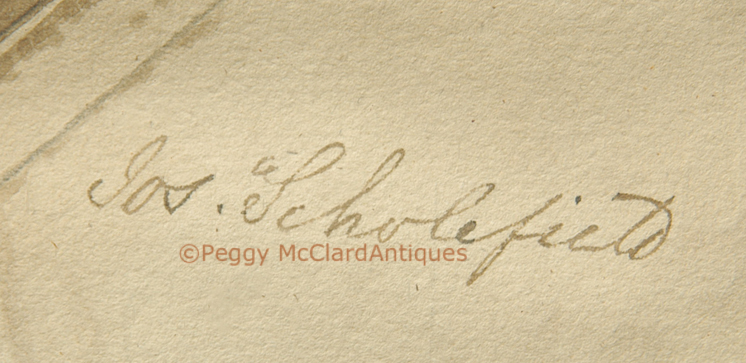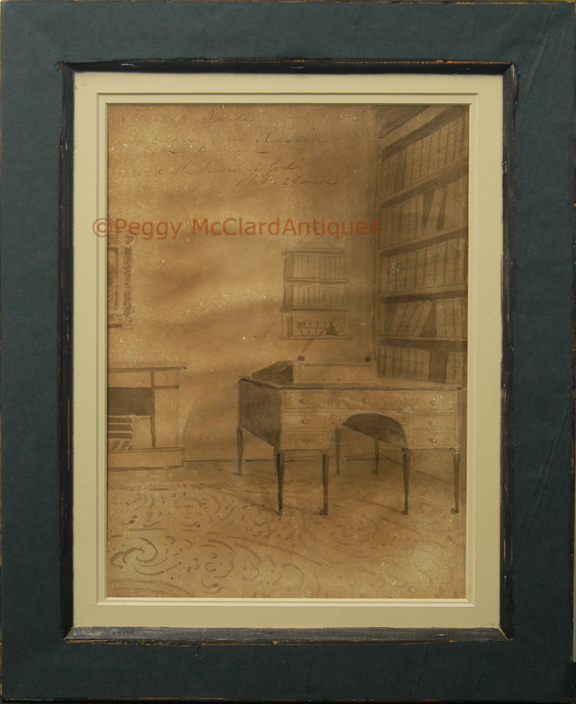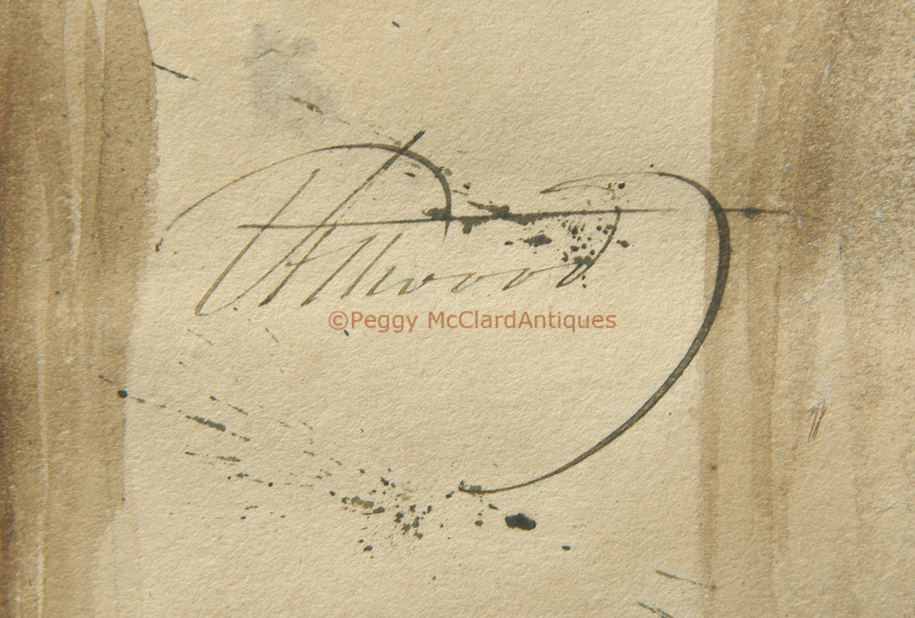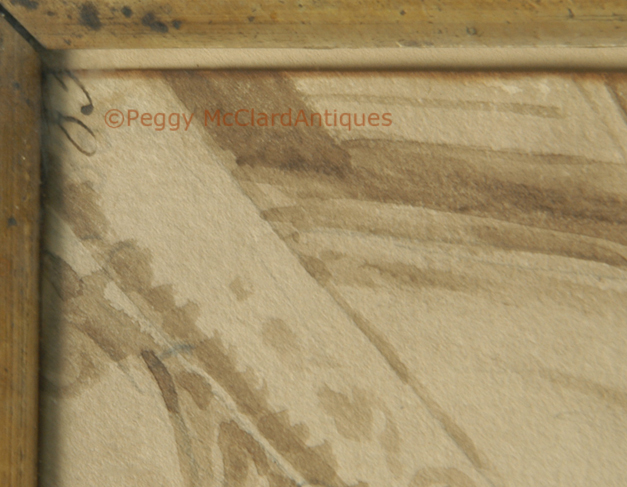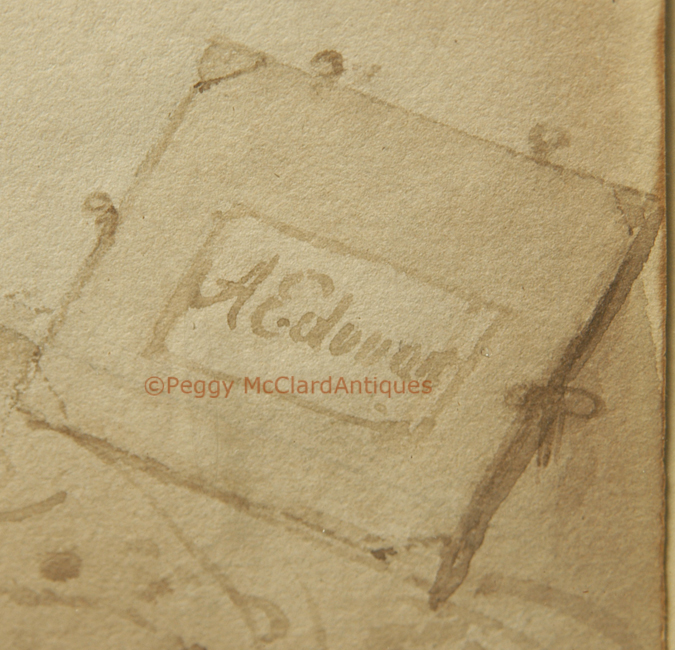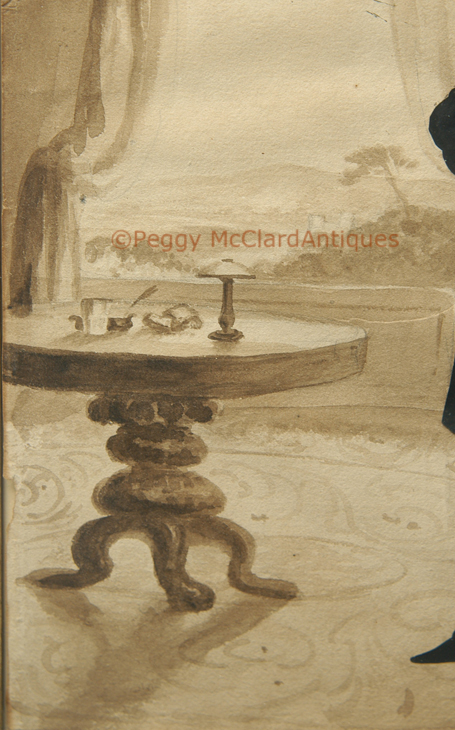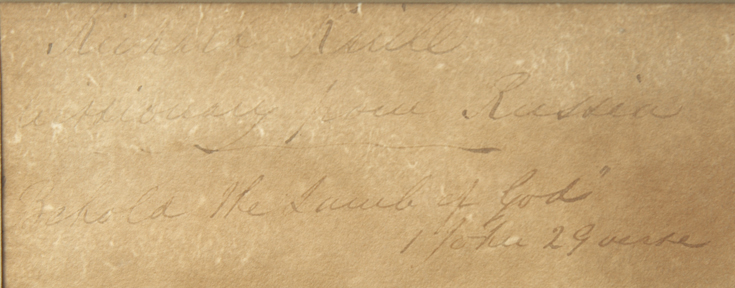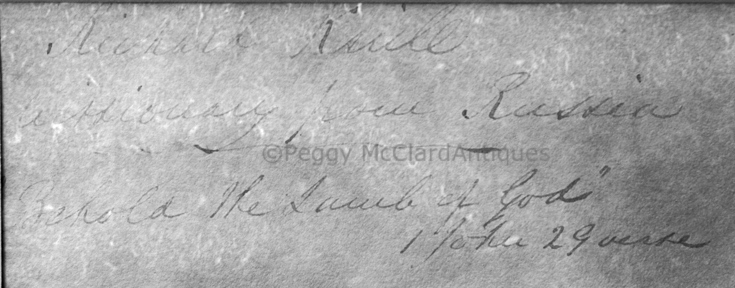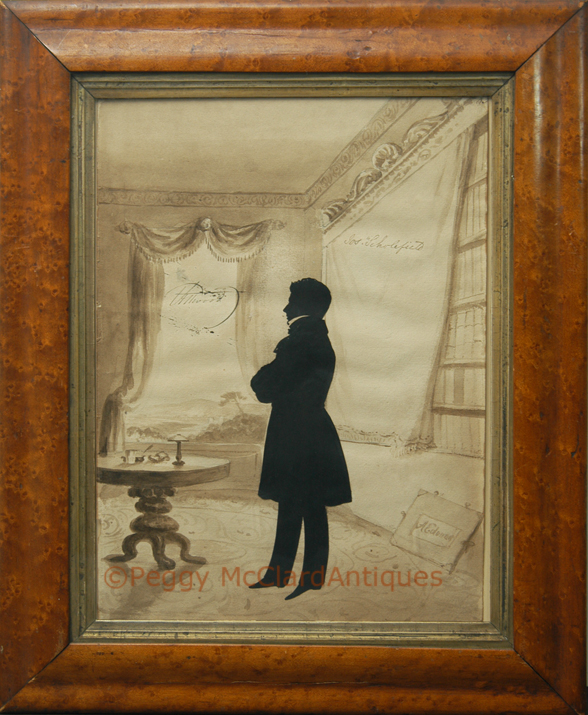
I am so pleased to offer 4 of what I consider ground-breaking silhouettes from one of Edouart’s “finished” folios. In 1923 a folio was sold by E.F. Bonaventure Inc, of New York to Miss Sarah C. Hewitt and referred to as “1 Vol. Silhouettes of eminent Americans by Edouart.” Bonaventure supposedly acquired the folio in Paris, but no clear records support that. The American folio includes single-sided pages of lithograph or watercolor backgrounds on which Edouart pasted figures of important Americans. Within that folio, Edouart had most of his sitters autograph the background on which the figure was pasted. He also usually included the date and place of titles along with descriptive titles of the sitters. The American folio is in the collection of the National Portrait Gallery in Washington DC. and is the focus on Auguste Edouart’s Silhouettes of Eminent Americans 1839 1844, Andrew Oliver, Published for the National Portrait Gallery, Smithsonian Institution by the University Press of Virginia, Charlottesville, 1977. Recently, another finished folio came up for auction. It contained important Irish figures--all subjects in the folio were men. The backgrounds were mostly lithographs with a few watercolor backgrounds. An 1838 advertisement by Edouart refers to “His Belfast Book of Public Characters”. Among other things, the ad reads, "His Belfast Book of Public Characters is likewise very interesting, by the correct delineations of the features, attitudes, and natural expression of our most distinguished personables who have honoured him with a sitting." Belfast News-Letter, Friday 23 November 1838. It seems clear that Edouart kept fully finished folios of distinguished citizens of places that he visited for marketing reasons. What better way to market your abilities as an artist than to present stunning folios gathering the most important people who have sat for you and presenting them on fully furnished backgrounds? These folios must have been very impressive to the people who flocked to Edouart’s arranged galleries throughout the British Isles and America.
Now, these four double-sided silhouettes with watercolor backgrounds indicate another “finished” folio by Edouart. Unfortunately, at this time, the only provenance we have for these silhouettes prior to 2014 is that the came from a private collection and had previously been purchased from David Ker Fine Art in London, probably during the 1980s. They came to me very recently from England and do not appear to have ever been framed. With the exception of the page with Sarah Hamilton, each page has Edouart’s page number written into one corner. (Apparently, Hamilton’s page number was previously cut off although the reverse of that page still contains its page number.) The pages are not all evenly cut and some of the writing is so close to the paper’s edge that it appears that the pages have been cut just a little. Considering the paper size of the recently offered Irish folio at Sotheby’s, each page is an appropriate size, which indicates that only slight edges have been cut. They came unframed and I had them framed in period bird’s-eye maple frames of similar (but not exact) profiles and similar (but not exact) profile period gilt liners. Early glass has been placed on the front and back of each silhouette. The pages are held in place between two pieces of acid-free ragboard, very lightly held with tiny dots of acid-free rice starch. Every effort was made to allow all writing and page numbers to remain visible. Unfortunately, in most cases, the page numbers had to necessarily be covered to avoid covering some of the more important inscriptions at the bottom of the pages. As will be noted in the individual listings, the very bottom edges of some of the pages is loose between the envelope of ragboard. This was necessary to allow the inscriptions to show but does allow the very bottom of the paper to swing freely when the silhouette is not stored in an upright position. I tell you this because there is a slight possibility that, during shipping, the very tiny amount of the top of the silhouette paper may pull loose from the top hinge of the ragboard frame and will require a trip to a good framer to open the frame and replace the paper between the ragboard with good conservation materials (i.e. rice starch). Some of the pages have very lightly penciled collection numbers in corners. Framed sizes are ever so slightly different because variables surrounding the effort made to show as much of each sheet of paper as possible and slight variations in sizes of the sheets of paper (which are each approximately 13 ½” x 10”).
This great silhouette is of Joshua (Jos.) Scholefield (23 May 1775 – 4 July 1844).
According to Wikipedia, “was a British businessman and Radical politician. He was elected as one of Birmingham's two first members of parliament when the town was enfranchised as a result of the Reform Act 1832.”
“Born in Sheffield, Yorkshire, by 1800 he had established himself as an iron manufacturer, merchant and banker at Birmingham. He subsequently became a director of the National Provincial Bank, the London Joint Stock Bank and the Metropolitan Assurance Company.”
“The growing industrial centre of Birmingham had neither local government nor parliamentary representation at the beginning of the nineteenth century. Scholefield became an advocate for municipal and parliamentary reform. In 1819 he was elected to the largely ceremonial position of high bailiff of Birmingham's Court Leet. In that capacity Scholefield chaired a meeting of Birmingham's businessmen in January 1820 that resolved to petition parliament to hold an inquiry into the ‘deplorable situation of the Manufacturing and Labouring classes of the Community and of this Town in particular; and the distressing situation to which Manufactures and Commerce are reduced’.”
“In 1830 he was a founding member of the Birmingham Political Union
along with his close friend Thomas Attwood. Scholefield became the
deputy chairman of the organisation, which campaigned for reform of
parliament. The Union's aims were achieved with the passing of the 1832
Reform Act.”
“The 1832 Act enfranchised Birmingham as a parliamentary borough, with
the right to return two members to the House of Commons. The Radicals,
who were dominant in the area, chose [Thomas] Attwood and Scholefield to
contest the seat. It was initially expected that they would contest the
seat with the Tories, but in the event the two men were elected
unopposed. Scholefield was re-elected at subsequent polls and remained a
member of parliament until his death. In parliament he opposed the new
poor law and supported the aims of the Chartists. On 24 June 1844 he
became ill, apparently with a stroke, and died on 4 July at his
residence in Birmingham, aged 69. He was buried in Edgbaston
churchyard.”1
Edouart depicted Scholefield with his arms folded in a library interior. Note the portfolio propped against the wall bearing the name “A. Edouart”. The detail cut to show Scholefield’s wavy hair is wonderful. Scholefield’s name inscribed on bookcase curtain. There is a second name inscribed in the window area (“T. Atwood”) but clearly there was never space for a second profile. The Atwood name appears to be an autograph although I feel like Scholefield’s name was written by Edouart. It is also in a darker ink and there is some smudging below the name. This leads me to believe that Atwood is signed in India ink as opposed to the iron gall ink that Edouart used. The upper right corner of the page has Edouarts written page number “83”. Scholefield is not listed in Mrs. Jackson’s list, meaning his duplicate was not among the folios that she acquired from the Lukis family.
The reverse of this page is a sepia backdrop of a library room with a tricky-to-read inscription across the top. My best guess is “Reikale Kuile / Missionary from Russia / Behold the Lamb of God / I John 29 verse.” There is no clear indication that a figure was pasted onto this page, but since there is an inscription, I assume that it did have a figure at one time. The reverse has darkened but you can still clearly enjoy the background painting. The upper left corner includes Edouart’s page number “84”. This name is also not listed in Mrs. Jackson’s list, meaning his duplicate was not among the folios that she owned. Framed size is 18 ¼” x 15”.
(#5572) $4500
1 “Joshua Scholefield:, Wikipedia, http://en.wikipedia.org/wiki/Joshua_Scholefield (gathered 12/15/2014). (Please forgive the direct quotes but I’ve run out of time for researching this! I will update when I find the time for more research.)
Please see the Silhouettist Bios page for more information about Auguste Edouart.

